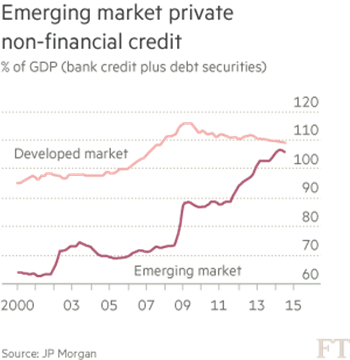
Emerging market private sector debt has surged by an “enormous” 33 per cent of gross domestic product since the global financial crisis, heightening the risk of financial crises, according to new analysis by JPMorgan.
根据摩根大通(JPMorgan)最新的分析,全球金融危机以后,新兴市场私营部门债务占国内生产总值(GDP)的比例激增33%,幅度“极大”,增大了爆发金融危机的风险。
The findings come amid mounting expectations that the US Federal Reserve is drawing close to its first rate rise since the crisis, a move many fear many reduce capital flows to emerging markets, potentially raising borrowing costs even if central banks do not raise policy rates in order to defend their currencies.
目前正值市场对美联储(Fed)加息预期上升——这将是美联储在金融危机之后的首次加息,许多人担忧此举将使流入新兴市场的资本减少,即使各国央行不提高政策利率以捍卫本币,借贷成本也可能因此上升。
JPMorgan’s analysis suggests that the debt burdens of emerging market companies and households have jumped from 73 per cent of GDP in 2007 to 106 per cent at the end of 2014, virtually as high as in the developed world, where private sector debt levels have been falling (see the first chart).
摩根大通的分析表明,新兴市场企业和家庭的债务负担占GDP的比例从2007年的73%跃升至2014年底的106%,几乎和发达国家一样高,而发达国家私营部门的债务水平一直在下降(见第一张图表)。
“In previous research, the IMF found that an increase in the ratio of credit to GDP of five percentage points or more in a single year signals a heightened risk of an eventual financial crisis,” says Joseph Lupton, senior global economist at JPMorgan.
“国际货币基金组织(IMF)在以前的研究中发现,信贷占GDP比例在一年中增加5个百分点以上,就预示着最终爆发金融危机的风险增大,”摩根大通高级全球经济学家约瑟夫勒普顿(Joseph Lupton)表示。
“Nearly half [of the EM countries analysed] have registered sustained increases at close to this amount over the entire period.”
“(所分析的新兴国家中)近一半在整个期间持续出现接近这一幅度的增长。”
Moreover, although the figures include domestic bank credit, cross-border loans extended to the non-bank private sector and debt securities issued by non-financial companies, it does not include shadow banking, due to a lack of data in many countries.
此外,尽管摩根大通的数据包括国内银行信贷、发放给非银行私营部门的跨境贷款和非金融企业发行的债券,但由于许多国家缺乏相关数据,该数据并不包含影子银行。
As a result, JPMorgan estimates that it is understating total private credit by around 10 per cent.
因此,摩根大通估计,其将私人信贷总水平低估了约10%。
Its greatest fear is that the supply of credit could tighten sharply, “triggering a crisis in some EM economies”.
该机构认为,最让人担忧的是信贷供给可能大幅收紧,“在一些新兴市场经济体引发一场危机”。
Mr Lupton notes that banks in a number of EM countries are already tightening lending standards in response to rising loan delinquencies and tighter funding conditions.
勒普顿指出,一些新兴市场国家的银行已经开始收紧放贷标准,以应对贷款违约率的上升和资金趋紧的状况。
Even if this does not escalate, however, he believes the rapid build-up of private sector debt will pose “a major headwind” for emerging market growth in the coming years.
即使局面没有进一步恶化,勒普顿认为,私营部门债务的迅速膨胀,也将对新兴市场未来几年的经济增长造成“重大阻碍”。
Citing the example of developed markets since the financial crisis, where economic growth has arguably been held back by household deleveraging, he believes the same phenomena is poised to happen in emerging markets.
可以说,金融危机后,发达市场的经济增长被家庭的去杠杆化所阻碍。勒普顿认为,相同的现象也即将在新兴市场发生。
“Emerging markets are just at the beginning of what is going to be a long and painful deleveraging cycle,” Mr Lupton said.
“新兴市场正处在一个漫长而痛苦的去杠杆化周期的开端,”勒普顿说。
“After seven years of a credit binge fuelled by easy money from the Fed the tide is going out and what’s going to be left to see is the quality of assets that have been bought over this period. There are going to be plenty of assets that are not going to be able to weather the Fed rate-hiking process.”
“在经历了长达7年、由美联储宽松货币政策推动的信贷狂潮后,潮水正在退去,剩下要看的是在这段时期内购买的资产的质量。将有许多资产无法经受住美联储的加息周期。”
Mr Lupton admits to being downbeat on the global economy as a whole, given that emerging markets now account for around 40 per cent of GDP, around twice the level during the 1997-98 EM crises, meaning a slowdown will have a greater effect on the world at large.
勒普顿承认,他对全球经济整体上抱悲观看法,因为新兴市场现在占全球GDP的约40%,大约是1997-98年新兴市场危机时期的两倍,这意味着新兴市场的放缓将对世界产生更严重的影响。
Furthermore, he believes the threat is not fully understood. “When we talk to clients we get a lot of emphasis on the rise in external debt, in particular to the corporate sector, but in many ways it pales versus the domestic credit that has been built up,” he says.
此外,他认为人们并未充分理解这一威胁。“我们与客户交谈时,发现人们很注重外债的上升,尤其是企业部门,但从很多方面来说,这与国内债务的增长相比就显得不那么重要了,”
The problem is most acute in Asia. Hong Kong, at 293.2 per cent, and Singapore, 178.9 per cent, have the highest ratios of private non-financial credit to GDP, although their status as regional financial centres, with a concentration of banking and capital markets activity, may skew the figures somewhat.
亚洲的问题最为严重。香港和新加坡是私人非金融信贷占GDP比例最高的两个地区,分别为293.2%和178.9%。不过作为地区金融中心,这两个地方是银行和资本市场活动的聚集地,这可能在某种程度上扭曲数据。
But even apart from this duo, the highest ratios are found in Asian countries such as Malaysia (170.7 per cent), South Korea (167.2 per cent), mainland China (147.1 per cent) and Thailand (134.4 per cent), as the second chart shows.
但就算排除这二者,如第二张图表所示,该比例最高的依然是在亚洲国家和地区,如马来西亚(170.7%)、韩国(167.2%)、中国内地(147.1%)和泰国(134.4%)。
Hong Kong and Singapore have also seen the largest rises in their private non-financial credit to GDP ratios since the end of 2007, with Hong Kong’s level rising by 110.5 percentage points (to $868bn) and Singapore’s by 63.3 points (to $541bn).
香港和新加坡也是自2007年底以来私人非金融信贷占GDP比例增幅最大的地区,其中香港增长了110.5个百分点(至8680亿美元),新加坡增长了63.3个百分点(至5410亿美元)。
Aside from these two, mainland China stands out. It has seen the largest rise in debt levels since 2007, of 42.7 percentage points, and has by far and away the largest stock of private non-financial sector debt in dollar terms, some $14.97tn, more than half of the $26.38tn of such debt in the 20 EM countries analysed by JPMorgan.
除了这两个地方,中国内地也十分突出。不算香港和新加坡,中国内地的私人非金融信贷占GDP比例上升最多,为42.7个百分点。以美元计算,中国内地的私人非金融部门债务存量也是最高的,达到约14.97万亿美元,超过摩根大通分析的20个新兴市场国家此类债务总和(26.38万亿美元)的一半。
The next largest stocks of debt were found in South Korea ($2.3tn), Brazil ($1.61tn) and India ($1.2tn).
在中国之后,债务存量最大的国家是韩国(2.3万亿美元)、巴西(1.61万亿美元)和印度(1.2万亿美元)。
Turkey, Thailand and Brazil have also seen rises of more than 30 percentage points in their debt ratio since the global financial crisis, figures Mr Lupton describes as “very big”.
全球金融危机后,土耳其、泰国和巴西的债务占GDP比例的上升也超过了30个百分点,勒普顿称这些数字“很大”。
Hungary, South Africa and Argentina were the only three of the 20 countries to see a fall in this measure. Argentina has the lowest ratio overall (15.4 per cent of GDP), followed by Mexico and Indonesia.
20个国家中,该指标出现下降的只有三个国家:匈牙利、南非和阿根廷。阿根廷还是所有国家中债务比例最低的(占GDP的15.4%),其后是墨西哥和印度尼西亚。
However, JPMorgan’s analysis suggests only around 8 per cent of the debt is foreign currency-denominated, lessening fears over rising repayments as emerging market currencies continue to weaken against the dollar.
然而,摩根大通的分析表明,只有约8%的负债是以外币计价的,这减轻了新兴市场货币相对美元持续走弱会造成偿债负担上升的忧虑。
In China, this figure is only around 2 per cent, although this still equates to about $300bn of debt.
在中国,这一数字仅为约2%,尽管此类债务的数额依然达到约3000亿美元。
The highest proportions of foreign currency-denominated private debt are believed to be in Mexico (47 per cent), Hungary (43 per cent), Singapore (40 per cent), Turkey (27 per cent) and Brazil (23 per cent).
以外币计价的私人债务比例最高的国家是墨西哥(47%)、匈牙利(43%)、新加坡(40%)、土耳其(27%)和巴西(23%)。
JPMorgan’s central forecast is that the Federal Reserve will raise rates by 175 basis points by the end of 2016, almost double market expectations of around 100bp.
摩根大通的核心预期是,美联储到2016年底将累计加息175个基点。这远高于市场预期的加息约100个基点。
“From the markets’ perspective, that is going to be somewhat jarring,” says Mr Lupton.
“从市场的角度来说,这多少将令人不安,”勒普顿说。











